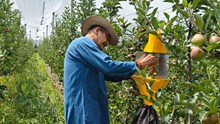
HS 542, commonly known as Pusa Kiran, is a semi-dwarf wheat variety developed by the ICAR-IARI, Regional Station, Shimla. Released in 2015, it is specifically bred to thrive under early sown rainfed conditions, making it an excellent choice for farmers in the North Eastern Hills. This variety exhibits high yield potential and strong resistance to stripe and leaf rust, ensuring both quality production and economic sustainability.
HS 542 was officially released in 2015 after extensive research and breeding efforts aimed at improving wheat's adaptability to rainfed conditions. The Indian Council of Agricultural Research (ICAR) and the Indian Agricultural Research Institute (IARI) Shimla Regional Station collaborated to develop this variety, ensuring its optimal performance in challenging environments. The variety was notified under Notification No. 268 (E) on 28.01.2015, marking its formal introduction into Indian agriculture.
HS 542 was notified for cultivation in the Northern Hills Zone (NHZ), covering states such as Himachal Pradesh, Uttarakhand, Jammu & Kashmir, and the North-Eastern States.
HS 542 (Pusa Kiran): Agronomic Characteristics
Growth and Morphology
HS 542 exhibits distinct morphological traits that contribute to its suitability for rainfed cultivation:
-
Plant Height: 91 cm – A semi-dwarf stature that enhances resilience against lodging.
-
Maturity Duration: 192 days – Ensuring optimal growth under early sown conditions.
-
1000 Grain Weight: 44g – Indicating heavy grain density for superior milling and processing quality.
Yield Potential
HS 542 demonstrates excellent yield performance, making it a valuable option for farmers seeking high productivity under limited water conditions:
-
Potential Yield: 49.3 q/ha – Maximum grain production achievable under optimal conditions.
-
Average Yield: 32.9 q/ha – Typical yield under standard rainfed cultivation.
Disease Resistance and Gene Postulation
HS 542 carries essential genetic traits that protect against major rust diseases, ensuring stable yields with minimal losses:
-
Yellow Rust Resistance Genes: Yr2+ – Providing immunity against stripe rust.
-
Brown Rust Resistance Genes: Lr13+10+ – Ensuring resilience against leaf rust.
This built-in disease resistance minimizes dependency on fungicides, reducing production costs and promoting sustainable farming practices.
Production Suitability
HS 542 is highly suited for early sown wheat cultivation in rainfed environments, making it particularly beneficial for farmers in the North Eastern Hills, where water availability and climatic challenges influence wheat farming practices. This variety thrives in moisture-deficient environments, ensuring high productivity even under rainfed conditions. It serves as a valuable alternative to older wheat varieties such as HS277 and VL829, providing higher yield potential and improved grain quality.
Quality Attributes and Economic Benefits
Chapati and Bread-Making Qualities
HS 542 is highly regarded for its excellent chapati-making and bread-baking qualities, making it ideal for both household consumption and commercial use. The variety produces well-textured flour, which enhances the quality of wheat-based products.
Seed Production and Distribution
To ensure availability for farmers in the NHZ, approximately 152 q of breeder seed has been supplied to seed-producing agencies under the official seed chain, facilitating the wider adoption of this variety.
Economic Benefits for Farmers
-
Higher Yield Potential ensures better profitability compared to conventional varieties.
-
Disease Resistance minimizes losses due to rust outbreaks, reducing input costs for pest and disease control.
-
Adaptability to Rainfed Conditions makes it economically viable in areas with inconsistent water availability.
-
Availability of Breeder Seed helps farmers access reliable planting material, encouraging widespread cultivation.
HS 542 (Pusa Kiran) is a scientifically advanced wheat variety designed to address the needs of rainfed wheat farming. Its high yield potential, strong disease resistance, and excellent grain quality make it an ideal choice for farmers seeking both sustainability and profitability. As climatic conditions continue to evolve, the role of resilient wheat varieties like HS 542 becomes ever more crucial in ensuring food security and proves to be an ideal choice, it serves as an ideal replacement for older wheat varieties while providing economic benefits and sustainable farming opportunities.
















